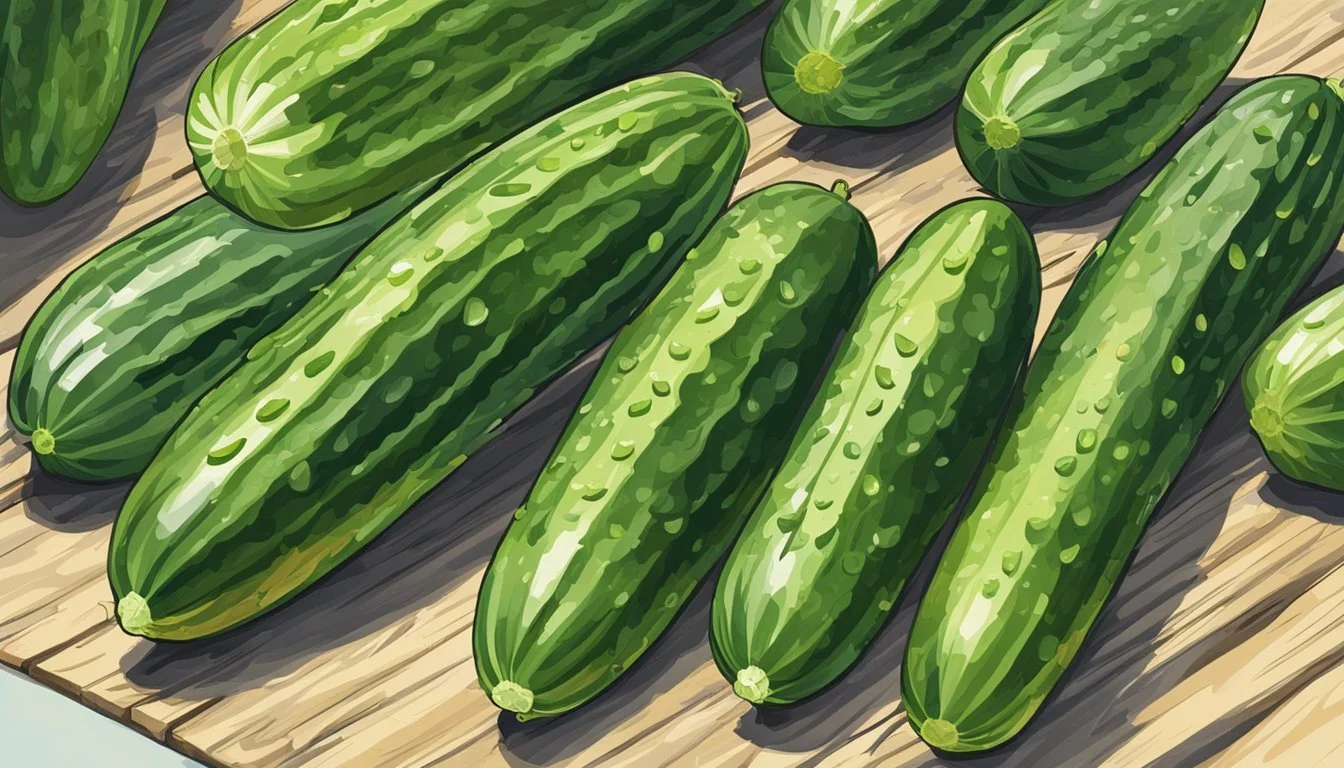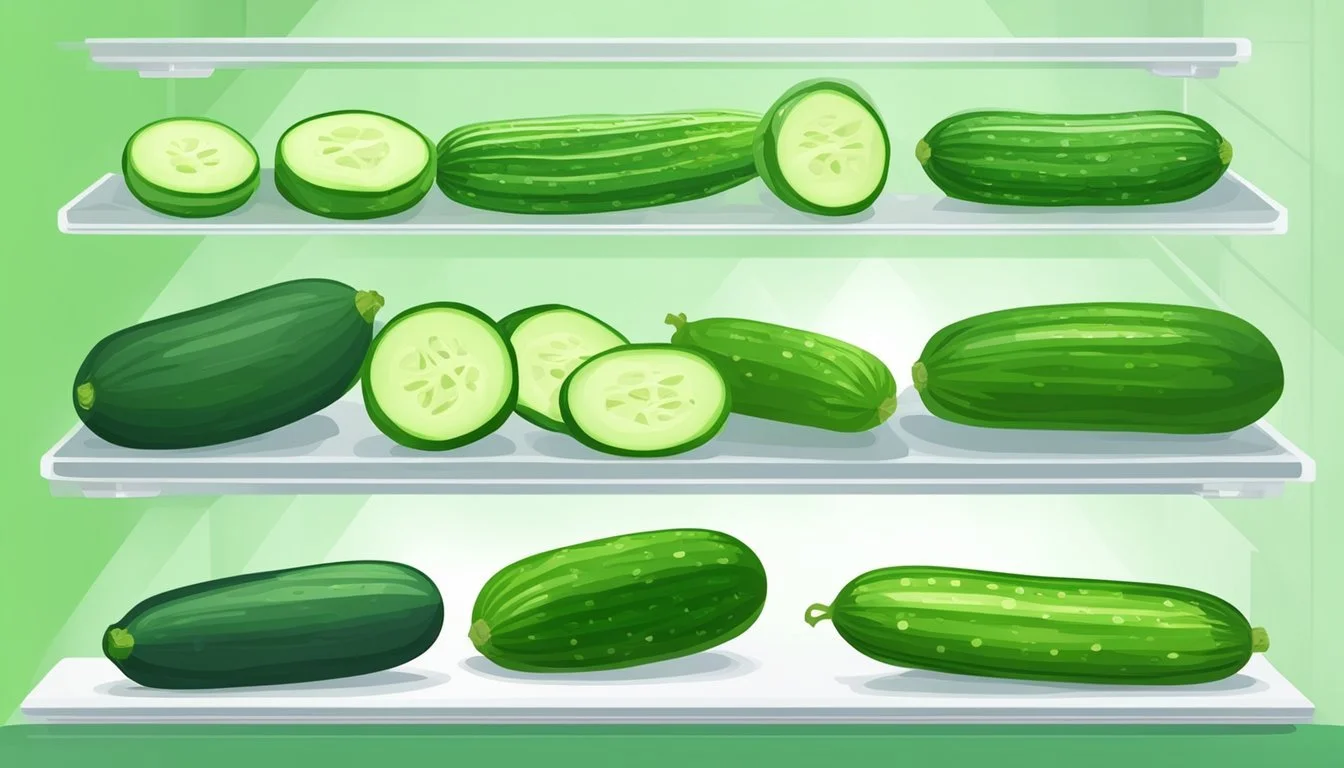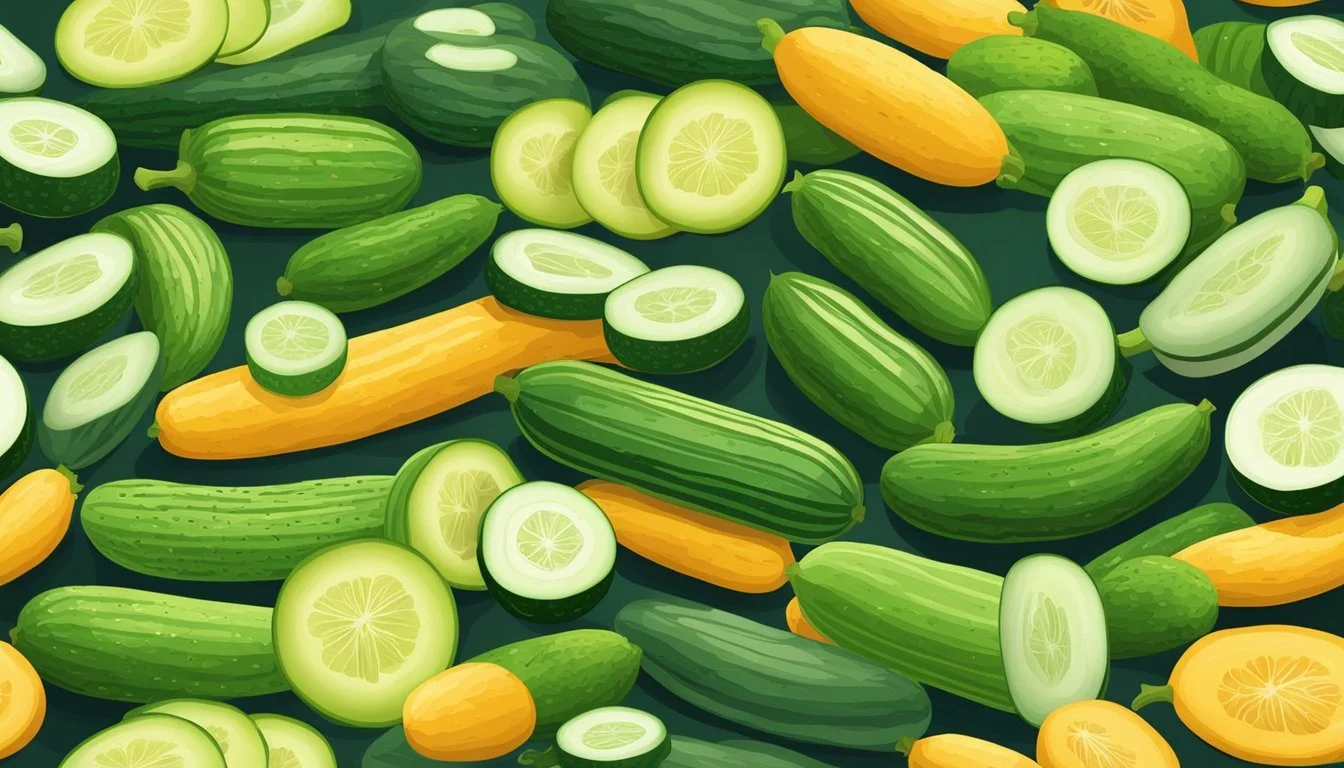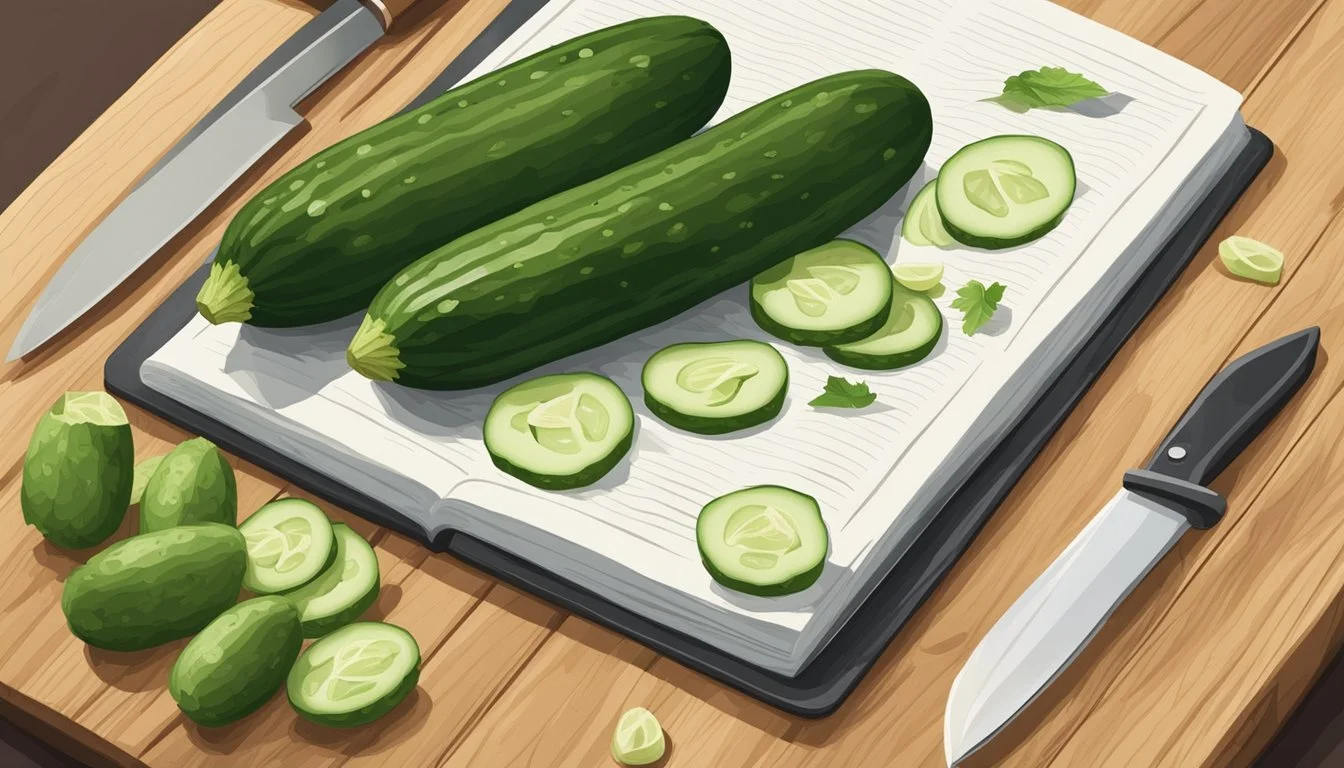How Long Do Cucumbers Last?
Shelf Life and Storage Tips
Cucumbers, like many fruits and vegetables, have a finite shelf life, the duration of which is contingent upon the methods used to store them. When kept under proper conditions, fresh cucumbers tend to last about two weeks. To maximize longevity, they are typically best stored in the refrigerator. The optimal temperature for cucumber storage is around 55 degrees Fahrenheit (13 degrees Celsius), which helps maintain their freshness and texture.
However, cucumbers are sensitive to temperatures below 40 degrees Fahrenheit (4 degrees Celsius) as they may develop pitting on the skin and water-soaked areas. Identifying the right storage method can ensure cucumbers retain their crispness and prevent premature spoilage. Common practices for cucumber storage include wrapping them in a paper towel and placing them inside a sealed zip-top bag in the refrigerator. This method is designed to maintain freshness and texture for an extended period.
Cucumber Fundamentals
Cucumbers are popular vegetables known for their high water content and crisp texture. Understanding how to store cucumbers is key to maximizing their shelf life and ensuring they remain fresh for consumption.
Storage: The environment in which cucumbers are stored greatly affects their longevity. They maintain their quality best in a cool, well-ventilated area. Ideally, cucumbers thrive at a storage temperature around 55°F (13°C). If they are kept at a temperature lower than 40°F (4°C), such as a standard refrigerator, they can develop pitting and water-soaked spots.
Shelf Life: The shelf life of cucumbers is variable but generally lasts from 1 to 2 weeks, depending on the storage conditions. When stored properly, cucumbers maintain their freshness and are less prone to spoilage.
Moisture Management: To prevent premature deterioration, cucumbers should be kept dry. Excess moisture can lead to a faster decay due to microbial growth. It is recommended to store them in perforated plastic bags to allow some air circulation.
Environment: A consistent environment is essential for prolonging the shelf life of cucumbers. Sudden changes in temperature or high humidity levels can negatively impact their quality.
Temperature Effect on Cucumbers Below 40°F (4°C) May cause pitting and water-soaked spots 55°F (13°C) Optimal for extended freshness and reduced spoilage
In summary, cucumbers require careful handling, with attention to temperature and moisture for optimally extending their shelf life.
Optimal Storage Conditions
Proper storage can significantly extend the freshness and shelf life of cucumbers. Maintaining the correct temperature and humidity is essential for ideal storage conditions.
Refrigerator Storage
In the refrigerator, cucumbers should be kept at a storage temperature just above 40°F to prevent them from becoming too cold and sustaining chill injury. Storing each cucumber individually wrapped in a paper towel and then placed in a plastic bag can maintain optimal humidity levels. For best results, cucumbers can be stored in the vegetable crisper drawer of the fridge. This compartment is designed to manage moisture levels effectively.
Method:
Wrap cucumbers in paper towels.
Place them in a zip-top plastic bag.
Store in the crisper drawer.
Temperature:
Just above 40°F (4.4°C).
Room Temperature Storage
Cucumbers may be kept at room temperature for a short period if they are to be consumed quickly. They should be stored away from direct sunlight and in a cool area. Extended storage at room temperature can lead to quicker deterioration and loss of freshness due to higher temperatures and exposure to ethylene gas produced by fruits such as bananas (how long do bananas last?) and tomatoes.
Precautions:
Store away from ethylene-producing fruits.
Ideal for short-term storage only.
Location:
A cool, shaded area.
Using these storage methods, individuals can maximize the shelf life of cucumbers while maintaining their crispness and freshness.
Signs of Spoilage
When identifying spoiled cucumbers, one should inspect for visual changes and feel the texture, as these are clear indicators of deterioration.
Visual Indicators
Mold Presence: Mold is a critical sign that cucumbers have gone bad. Look for fuzzy spots, which are often white, grey, or greenish.
Color Changes: Cucumbers with yellowing or dark spots have started to spoil.
Blemishes: Sunken areas or visible dents often indicate internal rot.
Texture Changes
Soft Spots: Probe the cucumber for areas that yield too much under gentle pressure; these soft spots suggest spoilage.
Sliminess: A slimy surface is a telltale sign that a cucumber should no longer be consumed due to bacterial growth.
Extending Cucumber Shelf Life
To maintain the freshness and quality of cucumbers for as long as possible, proper handling and storage techniques should be employed. This section provides practical methods to extend the shelf life of cucumbers through careful preparation and effective preservation techniques.
Handling and Preparation
Handling cucumbers with care is essential to prevent bruising and decay. Cucumbers should be washed under cool running water just before use, but not before storage, as excess moisture can hasten spoilage. They should also be thoroughly dried if they are washed inadvertently, ensuring that moisture loss is minimized during storage. To further prevent moisture loss, wrapping cucumbers individually in beeswax wrap or paper towels can be beneficial.
Preservation Techniques
A variety of techniques can be employed to preserve cucumbers:
Storing at Optimal Temperature: Cucumbers should be stored at a moderate temperature of about 55°F (13°C) to extend their shelf life without causing chilling injuries such as pitting or water-soaked spots.
Using Resealable Bags: Store cucumbers in resealable or zip-top bags to keep out excess air and moisture. Placing a folded paper towel in the bag can absorb extra moisture and help prevent spoilage.
Pickling: Cucumbers can be preserved for months by pickling them. This involves submerging cucumbers in a vinegar or brine solution, which inhibits bacterial growth.
Canning: Cucumbers are also suitable for canning, a method which heats them to destroy bacteria and seals them in an airtight container to prevent recontamination.
Freezing: While freezing cucumbers is not recommended for raw salad use due to textural changes, frozen cucumbers can still be used in cooked dishes or smoothies.
By carefully preparing cucumbers for storage and employing these preservation techniques, their shelf life can be significantly extended.
Specific Cucumber Varieties
Different cucumber varieties not only exhibit unique characteristics and flavors but also have distinct shelf lives that should be considered when purchasing or storing them.
English Cucumbers
English cucumbers are long, thin, and typically sold in plastic wrapping which aids in extending their shelf life. Lifespan: Under proper refrigeration, English cucumbers can last up to two weeks.
Persian Cucumbers
Persian cucumbers are smaller and can be recognized by their bumpy skin. Lifespan: These types of cucumbers are known for a shorter shelf life, often lasting about a week in the refrigerator before showing signs of spoilage.
Pickling Cucumbers
Pickling cucumbers are robust and ideal for preserving. Lifespan: If they are stored in a cool, dry place, they can stay fresh for up to one week. However, once pickled, their shelf life extends dramatically, often up to two years when properly canned.
Cucumber Uses in Recipes
Cucumbers add a fresh crunch and hydrating flavor to a variety of dishes. This section explores their role in culinary preparations, specifically in salads, sandwiches, smoothies, relishes, pickles, and crudites.
Salads and Sandwiches
In salads, cucumbers serve as a crisp component and are often used in conjunction with leafy greens, tomatoes, and vinaigrette dressings. They are a staple in Greek salads, paired with feta cheese and olives. For sandwiches, thinly sliced cucumbers provide a refreshing crunch and moisture, making them a favored ingredient in tea sandwiches and subs.
Greek Salad: Diced cucumbers, tomatoes, feta cheese, olives, onion, olive oil.
Cucumber Sandwiches: Sliced cucumbers, cream cheese, white bread, herbs.
Smoothies and Relishes
Cucumbers are frequently included in green smoothie recipes due to their high water content and subtle flavor, which do not overpower other ingredients. They blend well with fruits like apples and citrus. As for relishes, cucumbers lend a crisp texture and can be combined with onions, peppers, and vinegar to create a tangy accompaniment to dishes.
Green Smoothie: Cucumber, spinach, green apple, lemon juice, ginger.
Cucumber Relish: Chopped cucumbers, red onion, red bell pepper, vinegar, sugar.
Pickles and Crudites
Pickling transforms cucumbers into a tangy condiment. Slicing cucumbers are often used for making pickles, especially for varieties like bread-and-butter or dill. Crunchy cucumber sticks or rounds, known as crudites, are commonly served with dips such as hummus or ranch as a healthy snack option.
Dill Pickles: Sliced cucumbers, dill, garlic, vinegar brine.
Crudites: Cucumber sticks or rounds, assorted dips like hummus or ranch dressing.
The diverse applications of cucumbers in recipes showcase their versatility and ability to enhance dishes with their distinct taste and texture.
Factors Influencing Cucumber Longevity
Temperature: Cucumbers thrive at cooler temperatures, ideally between 10°C and 13°C (50-55°F). Storing cucumbers at this temperature range extends their freshness.
Humidity: A humid environment can support cucumber longevity. High humidity levels around 95% are optimal, yet care must be taken to prevent excess moisture that could foster decay.
Handling: Gentle handling of cucumbers is crucial. Bruises or damage can accelerate spoilage.
Ripeness: The stage of ripeness affects shelf life. Cucumbers picked when fully ripe may last longer than those picked prematurely, up to two weeks with ideal conditions.
Storage with Ethylene-Producing Fruits: Cucumbers are sensitive to ethylene gas, which is emitted by certain fruits like bananas, tomatoes, and avocados. Isolating cucumbers from these can prevent premature ripening and spoilage.
Seasonal Variations: In summer, higher ambient temperatures might shorten the storage life of cucumbers unless they are kept in a controlled environment.
In summary, cucumbers' longevity is contingent upon thoughtful consideration of the aforementioned factors, ensuring that they retain their freshness for as long as possible.
Cucumber Selection and Buying Tips
When purchasing cucumbers, one should prioritize firmness and lack of blemishes. These physical qualities are indicative of freshness and good condition. Specifically, buyers should:
Avoid: Cucumbers with soft spots, bruises, or cuts.
Look for: Firm texture, bright color, and a uniform shape.
To ascertain the ripeness of a cucumber, assess its firmness and color. A ripe cucumber is typically dark green, firm to the touch, and heavy for its size.
Assessing Quality:
Skin: Should be smooth and free from wrinkles or shriveling.
Shape: Choose cucumbers that are evenly cylindrical; irregular cucumbers might have uneven texture or flavor.
Size: Smaller cucumbers tend to have fewer seeds and can be more flavorful.
Here's a simplified checklist for buying cucumbers:
Quality Aspect What to Check Firmness Should resist pressure when squeezed lightly. Surface Should be free of blemishes or deep indentations. Color Should be a consistent, vibrant dark green. Size Larger for salads, smaller for pickling.
Proper selection is pivotal, as it affects longevity and enjoyment of the cucumbers. Buyers should feel confident when selecting cucumbers by employing these tips to ensure they get the best quality for their needs. Remember, the overall appearance can often inform one about the internal quality of the produce.
Proper Food Storage Practices
Effective storage practices are essential for extending the shelf life of produce like cucumbers. These practices include knowing which foods to store together and selecting appropriate containers that maintain freshness and taste.
Food Pairing
Cucumbers should be stored away from ethylene-producing foods such as melons, tomatoes, and bananas. Ethylene can promote over-ripening and spoilage. Lettuce and other greens can be stored with cucumbers as they do not produce significant amounts of ethylene. Additionally, ensuring proper airflow around produce can help prevent moisture accumulation and potential spoilage.
Container Selection
When refrigerating cucumbers, the selection of the right container is crucial. Cucumbers last longer when they are kept:
In a crisper drawer to manage humidity levels.
Wrapped individually in paper towels to absorb excess moisture.
Placed within an open or slightly closed plastic bag to allow for ethylene gas to escape and not build up around the vegetable.
For cut cucumbers:
Store them in airtight containers to prevent dryness and contain their moisture.
Sandwiching a piece of paper towel between slices in the container can help absorb extra moisture and keep them crisp.
Using these methods will aid in preserving cucumbers' freshness while stored in the fridge.
Conclusion
Cucumbers have a variable shelf life depending on storage conditions. When kept at room temperature, one can expect cucumbers to remain fresh for approximately one to two weeks. However, this duration is contingent upon the absence of direct sunlight and extreme heat, which can accelerate spoilage.
Refrigeration can extend their shelf life, with cucumbers typically staying crisp for up to a week. Specific varieties, such as English and Persian cucumbers, might last slightly longer, from seven to ten days. It is crucial for their preservation to be stored in a cooler setting, ideally between 50-60 degrees Fahrenheit.
For those involved in gardening, selecting cucumbers at peak freshness is key. They should be firm to the touch and exhibit a uniform color. Signs of deterioration include soft spots, wrinkling, or discoloration. To maintain optimal freshness, one should also ensure cucumbers are dry, as excess moisture promotes decay.
Proper Storage Techniques:
Room Temperature: 1 to 2 weeks
Refrigerated: Up to 1 week; varies by cucumber type
Ideal Conditions: Cool, dark, and dry environment
Consistently employing these methods will significantly impact the longevity of cucumbers post-harvest. The author's garden-to-table knowledge reinforces that paying close attention to storage nuances is essential for maintaining the freshness and edibility of this crisp, versatile vegetable.











